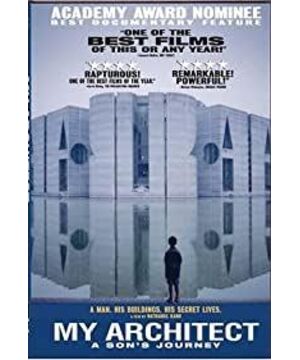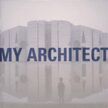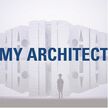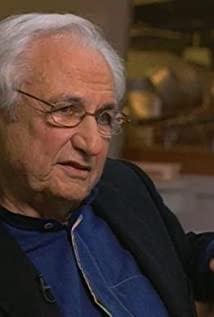With such a slightly sad mood, the director visited the three families one after another. Ironically, despite the film's title "My Architect," Louis Kahn clearly doesn't belong to any of them. He almost ignored his relatives, used to spend Christmas at friends' houses, and when he died alone at Penn Station of a heart attack at the age of 72, he was found to have scribbled out thoroughly with black pen. the address on the passport. However, unlike the same kind of subject's treatment of "successful man and his three wives and four concubines", the interviewees remained surprisingly calm. One of Kang's lovers (and the director's mother) lives alone on an island: "I'm a romantic fatalist, and even if someone comes, I'm still lonely." (So Louis Kang never came) Another A lover said: "I always felt that we were one big family at heart." The almost grim tone had long had an almost absurd effect - through the deliberate beautification of Kang's bigamy, the director turned the focus to "loneliness" : People who are so talented and hard to find soulmates have their spiritual roots in a deeper and farther soul, and they have to use this "alternative" way to deal with their loneliness.
This kind of loneliness is stretched to the extreme, and this "Journey to Find Father" has been achieved. What kind of impulse do people have when they want to understand their father, especially a father who was completely absent from his growth? Based on my 23 years of experience, the answer I can guess is that when a child grows from being completely ignorant of the world to being a little bit involved in it, he will especially want to know that he used to be so tall and majestic that he was close to himself. The irrelevant father actually crawls on the ground in a humanized attitude - I always doubt that the child who sets out on the road with this attitude will have some pride in his heart and the pride of a victor in his heart. But what is tangled is that the director's father is Louis Kahn. The more he embraces his father's architecture, the more he highlights his insignificance.
As the film progresses, the buildings involved get bigger and bigger, and more and more meanings are drawn in: arguing for radical urban planning ideas in Philadelphia, with the Old Howa Synagogue "using a building" to unite the Jews of the world"...abandoned his father and cast down the patriarchy as a huge shadow that would last far longer than his life: a huge, boundless, indifferent, alienated Father. The director himself said: "I always feel that my father is not dead, but alive somewhere." This is of course, because the father did not exist in his life at all. The director can only learn about the father from architectural documents, not only did the father's tie never exist in the home, but the father's relatives didn't even know he existed. The layers of foreshadowing finally led to the speech of the Bangladeshi interviewee: "He is like Moses, who gave us democracy... He brought us democratic institutions in one building. He may have slighted the family around him. . . . but he has great love."
Given that power and ambition are the foundation of all great architecture, the so-called "big love" is probably also the kind of love that can only be possessed by great people who can do such great things - the intention of the film seems to be that Kang's emotional size is too large and large. To the point where not only can we not fit into the too small space of the family, but we can completely ignore such mundane things as money (Kang was in debt when he passed away), we made sacrifices for Kang's great love. However, it is precisely because "big love" and "little love" are not contradictory, and I don't really understand the reasoning process of "bringing democracy to Bangladesh with one building" (this part that should be the focus is obviously not the director The core of what I want to express), many episodes - such as Kang's friend crying on the spot when the director reveals his identity - exudes a strange sense of incongruity: I am for a great father like Louis Kang. I feel proud, but it cannot change the fact that he does not love me very much, so in order to achieve a balance between these two emotions, I can only use a bigger excuse to cover up the voids and faults - if I can't make Louis Kahn infinite Lifting it up, the pain experienced before is almost in vain. According to this, this entanglement brings a bit of Stockholm flavor.
Compared to its unconvincing ambiguity about family issues, the film's more heartfelt presentation is the concept of "genius." Louis Kahn, who was presented to the audience through photos and documents, was a tyrannical genius who was invincible and devastated, devoting himself to architecture. His legend began as early as when he crossed the sea from Estonia to the United States: because he suffered burns as a child, his father immediately said "we don't want this child", but his mother thought that he was doomed in the future. To be big. The scars left by the burns, the identity of Jewish immigrants, and the short stature of 167cm, the three characteristics have created his Prometheus-style tormented life-when the vision is large enough to stand at the forefront of mankind, people often think you are crazy; Given the nature of creativity to see what no one else can see, while rejoicing at the surge of new ideas, you can also be engulfed in great depression by uncertainty about their authenticity; your ideas are way ahead of their time , so you have to defend them alone to deal with many doubts and rejections; if you want to be a real master, it is even more serious to pull the soul - not only can you see the huge picture beyond reality, but also need to He has the ability to turn it into reality brick by brick - so his ambition to steal fire also binds him firmly to the endless suffering of eagle pecking at the liver, so as to build a "fingertip, thought, A miracle of technology".
Let's go back to the theme of "loneliness" earlier. What the film is about is actually how a group of detached people guard their loneliness. For Kang, it may be that successful people really have sperm on their brains during work breaks; for them, it is "if partners can't satisfy each other spiritually, why not live a life of physical loneliness". Some people are satisfied with the enjoyment of the world, and some people are destined to look up at the starry sky; the sky is full of dark clouds, and it takes a lot of effort and effort to look up; so some people become Louis Kahn, but more people Nothing but mediocre scum, sulking to the end in a self-deceiving intoxication. You could say that such a choice is neither worthy nor moral, but the place is so beautiful! So they still have to run up one after another. Nature cannot make it, but humans can.
View more about My Architect reviews










